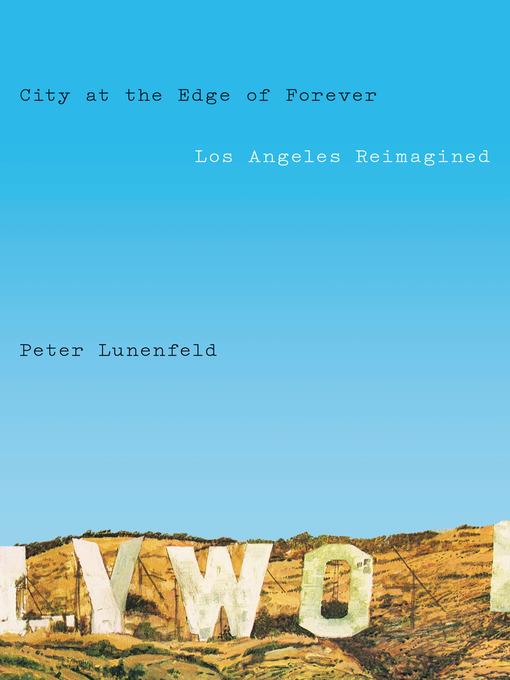
City at the Edge of Forever
Los Angeles Reimagined
کتاب های مرتبط
- اطلاعات
- نقد و بررسی
- دیدگاه کاربران
نقد و بررسی

May 15, 2020
A kaleidoscopic view of Los Angeles that looks beyond stereotypes of "freeways, sprawl, movie stars, and New Age nonsense." Lunenfeld, a native New Yorker who is now a professor of design media arts at UCLA, pens a valentine to his adopted city, where he moved to attend graduate school. Erudite and fact-packed but self-indulgent and inefficiently organized, his book rests on the conceit that LA has moved through interlocking phases corresponding to the five elements of alchemy--"from earth to fire to air to water" and the more elusive "aether" or "the quintessence." That framework gives Lunenfeld ample and welcome room to cover often overlooked topics such as the city's once-powerful aerospace industry and the ports of LA and Long Beach, whose waters are "the largest and busiest in the United States." Throughout, the author forges many offbeat connections. He links, among others, Walt Disney and Hugh Hefner (both of whom let people enter a "dreamscape" and interact with its denizens, Mickey at Disneyland and the bunnies at Playboy clubs) and two married couples who blazed trails as they combined work and love: midcentury-modern designers Charles and Ray Eames and the authors Will and Arial Durant. Lunenfeld's "alchemical" stages overlap and progress in nonlinear ways, which leads to continual jump-cuts back and forth in time, place, and theme, an approach that can be disorienting. The text sometimes devolves into tourist-board prose: No other metropolitan area, writes the author, "can boast of the presence of two presidential libraries," Nixon's and Reagan's. Unlike Joan Didion--that austere, minimalist bard of California--Lunenfeld is a maximalist who overstuffs his argument that LA triumphed through "its ramp-up of the arts, architecture, design, cuisines, music, theater, and literary cultures, not to mention technical and scientific accomplishments, at a speed and with a reach unprecedented in human history." He makes a strong case for the city's exceptionalism, but via a route that requires the patience of navigating the LA freeways. Slouching toward Los Angeles on an alternately pleasant and frustrating detour-filled highway.
COPYRIGHT(2020) Kirkus Reviews, ALL RIGHTS RESERVED.

Starred review from May 25, 2020
UCLA digital media scholar Lunenfeld (coauthor, Digital_Humanities) draws surprising links between the artistic, economic, and political milieus of Los Angeles in this immersive cultural history. Casting his adopted hometown as an “alchemical city,” Lunenfeld explores how L.A.’s identity has been shaped by its embodiment of the five classical elements: available land (earth) was gobbled up by Yankee settlers and real estate speculators in the 19th century; nearby oil fields (fire) fueled the cars that made suburban development possible in the early 20th century; the aerospace industry (air) took off from WWII through the 1980s; the city’s ports (water) have been a key driver of globalization since the 1990s; and the allure of Hollywood (aether) has captured the world’s imagination for more than a century. Highlighting L.A.’s melting pot nature, Lunenfeld writes that southern California’s surfing craze and its modernist architecture both owe their existence to émigrés from the Austro-Hungarian empire, connects the Jet Propulsion Laboratory to sci-fi fandom and cosplay, and traces the roots of the city’s “resolutely contemporary” Asian food scene to 1950s and ’60s tiki bars. Richly detailed and evocatively written, this highly original account unearths L.A. stories “more complex contradictory... than anything that ever made it to the screen.” Readers will be spellbound. Agent: Joe Spieler, the Spieler Agency.

June 12, 2020
Lunenfeld's (Snap to Grid) latest collection of essays finds itself at the intersection of cultural theory, aesthetics, and technology--territory familiar to the author. In this work, the author weaves stories of the history that made Los Angeles the (oft-stereotyped) landmark it is and draws some cautionary conclusions about the city's future. These pieces link the seemingly unrelated (e.g., Hugh Hefner and Walt Disney; surfing culture and Austro-Hungarian immigrants), but speak to Lunenfeld's view of L.A. as an alchemical city, where its elemental air, earth, water, fire, and aether--seen in this case as Hollywood's glamour--combine to create a place that feels perpetually at the edge of forever. This book delves into both the stereotypes and glitz of Hollywood, while also pointing out L.A.'s underlying racism, injustice, and intolerance that exploded into rioting and unrest on several occasions. The author proffers both praise and critique in equal measure, offering a distinct perspective on a city he clearly loves, drawing connections and highlighting serendipities that make the sprawling metropolis so quintessentially itself. VERDICT Readers with an interest in modern U.S. history, pop culture, and art and architecture should find this to be engaging.--Crystal Goldman, Univ. of California, San Diego Lib.
Copyright 2020 Library Journal, LLC Used with permission.

July 1, 2020
Lunenfeld, a professor at UCLA who specializes in digital culture, explains Los Angeles through a canny use of alchemy, a pairing of unlikely people or ideas, resulting in thoughtful, even startling illustrations for how that community has evolved. Joan Didion, that exemplar of L.A. cool, is linked to the exuberantly blond Angelyne, whose 1980s billboards made her famous for being famous, by the muscular Corvette Stingray?Didion's was yellow, Angelyne's pink?an American icon designed by the brash Larry Shinoda, whose Japanese American family had been shipped from L.A. to an internment camp during WWII. Historians Will and Ariel Durant are paired with designers Charles and Ray Eames to launch an exploration into modernism, commercial appeal, the home as office, and wifely authorial/design credit denied. Fantasists Walt Disney and Hugh Hefner are compared and contrasted. So it is with the vast range of L.A. innovations Lunenfeld addresses, from the sushi bar to martial arts to surfing to aerospace to science fiction to food to pop music and on and on. One fresh take on a great city.(Reprinted with permission of Booklist, copyright 2020, American Library Association.)

























دیدگاه کاربران